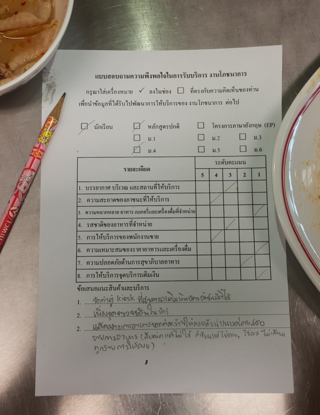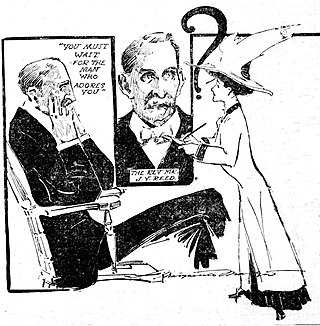Related Research Articles

Analysis is the process of breaking a complex topic or substance into smaller parts in order to gain a better understanding of it. The technique has been applied in the study of mathematics and logic since before Aristotle, though analysis as a formal concept is a relatively recent development.

An interview is a structured conversation where one participant asks questions, and the other provides answers. In common parlance, the word "interview" refers to a one-on-one conversation between an interviewer and an interviewee. The interviewer asks questions to which the interviewee responds, usually providing information. That information may be used or provided to other audiences immediately or later. This feature is common to many types of interviews – a job interview or interview with a witness to an event may have no other audience present at the time, but the answers will be later provided to others in the employment or investigative process. An interview may also transfer information in both directions.
Questionnaire construction refers to the design of a questionnaire to gather statistically useful information about a given topic. When properly constructed and responsibly administered, questionnaires can provide valuable data about any given subject.
Survey methodology is "the study of survey methods". As a field of applied statistics concentrating on human-research surveys, survey methodology studies the sampling of individual units from a population and associated techniques of survey data collection, such as questionnaire construction and methods for improving the number and accuracy of responses to surveys. Survey methodology targets instruments or procedures that ask one or more questions that may or may not be answered.
Qualitative marketing research involves a natural or observational examination of the philosophies that govern consumer behavior. The direction and framework of the research is often revised as new information is gained, allowing the researcher to evaluate issues and subjects in an in-depth manner. The quality of the research produced is heavily dependent on the skills of the researcher and is influenced by researcher bias.
A respondent is a person who is called upon to issue a response to a communication made by another. The term is used in legal contexts, in survey methodology, and in psychological conditioning.

A questionnaire is a research instrument that consists of a set of questions for the purpose of gathering information from respondents through survey or statistical study. A research questionnaire is typically a mix of close-ended questions and open-ended questions. Open-ended, long-term questions offer the respondent the ability to elaborate on their thoughts. The Research questionnaire was developed by the Statistical Society of London in 1838.

Response bias is a general term for a wide range of tendencies for participants to respond inaccurately or falsely to questions. These biases are prevalent in research involving participant self-report, such as structured interviews or surveys. Response biases can have a large impact on the validity of questionnaires or surveys.
Computer-assisted personal interviewing (CAPI) is an interviewing technique in which the respondent or interviewer uses an electronic device to answer the questions. It is similar to computer-assisted telephone interviewing, except that the interview takes place in person instead of over the telephone. This method is usually preferred over a telephone interview when the questionnaire is long and complex. It has been classified as a personal interviewing technique because an interviewer is usually present to serve as a host and to guide the respondent. If no interviewer is present, the term Computer-Assisted Self Interviewing (CASI) may be used. An example of a situation in which CAPI is used as the method of data collection is the British Crime Survey.
In social science research, social-desirability bias is a type of response bias that is the tendency of survey respondents to answer questions in a manner that will be viewed favorably by others. It can take the form of over-reporting "good behavior" or under-reporting "bad", or undesirable behavior. The tendency poses a serious problem with conducting research with self-reports. This bias interferes with the interpretation of average tendencies as well as individual differences.
Cognitive pretesting, or cognitive interviewing, is a field research method where data is collected on how the subject answers interview questions. It is the evaluation of a test or questionnaire before it's administered. It allows survey researchers to collect feedback regarding survey responses and is used in evaluating whether the question is measuring the construct the researcher intends. The data collected is then used to adjust problematic questions in the questionnaire before fielding the survey to the full sample of people.
Acquiescence bias, also known as agreement bias, is a category of response bias common to survey research in which respondents have a tendency to select a positive response option or indicate a positive connotation disproportionately more frequently. Respondents do so without considering the content of the question or their 'true' preference. Acquiescence is sometimes referred to as "yea-saying" and is the tendency of a respondent to agree with a statement when in doubt. Questions affected by acquiescence bias take the following format: a stimulus in the form of a statement is presented, followed by 'agree/disagree,' 'yes/no' or 'true/false' response options. For example, a respondent might be presented with the statement "gardening makes me feel happy," and would then be expected to select either 'agree' or 'disagree.' Such question formats are favoured by both survey designers and respondents because they are straightforward to produce and respond to. The bias is particularly prevalent in the case of surveys or questionnaires that employ truisms as the stimuli, such as: "It is better to give than to receive" or "Never a lender nor a borrower be". Acquiescence bias can introduce systematic errors that affect the validity of research by confounding attitudes and behaviours with the general tendency to agree, which can result in misguided inference. Research suggests that the proportion of respondents who carry out this behaviour is between 10% and 20%.
Protocol analysis is a psychological research method that elicits verbal reports from research participants. Protocol analysis is used to study thinking in cognitive psychology, cognitive science, and behavior analysis. It has found further application in the design of surveys and interviews, usability testing, educational psychology and design research. With the introduction of video- and audio-based based surveys, the scale and scope of verbal report collection is increased dramatically compared to in-person verbal report recording.
A situational judgement test (SJT), or situational stress test (SStT) or inventory (SSI) is a type of psychological test which presents the test-taker with realistic, hypothetical scenarios and ask them to identify the most appropriate response or to rank the responses in the order they feel is most effective. SJTs can be presented to test-takers through a variety of modalities, such as booklets, films, or audio recordings. SJTs represent a distinct psychometric approach from the common knowledge-based multiple choice item. They are often used in industrial-organizational psychology applications such as personnel selection. Situational judgement tests tend to determine behavioral tendencies, assessing how an individual will behave in a certain situation, and knowledge instruction, which evaluates the effectiveness of possible responses. Situational judgement tests could also reinforce the status quo with an organization.
Netnography is a specific type of qualitative social media research. It adapts the methods of ethnography to understand social interaction in contemporary digital communications contexts. Netnography is a specific set of research practices related to data collection, analysis, research ethics, and representation, rooted in participant observation. In netnography, a significant amount of the data originates in and manifests through the digital traces of naturally occurring public conversations recorded by contemporary communications networks. Netnography uses these conversations as data. It is an interpretive research method that adapts the traditional, in-person participant observation techniques of anthropology to the study of interactions and experiences manifesting through digital communications.
With the application of probability sampling in the 1930s, surveys became a standard tool for empirical research in social sciences, marketing, and official statistics. The methods involved in survey data collection are any of a number of ways in which data can be collected for a statistical survey. These are methods that are used to collect information from a sample of individuals in a systematic way. First there was the change from traditional paper-and-pencil interviewing (PAPI) to computer-assisted interviewing (CAI). Now, face-to-face surveys (CAPI), telephone surveys (CATI), and mail surveys are increasingly replaced by web surveys. In addition, remote interviewers could possibly keep the respondent engaged while reducing cost as compared to in-person interviewers.

Computer-assisted survey information collection (CASIC) refers to a variety of survey modes that were enabled by the introduction of computer technology. The first CASIC modes were interviewer-administered, while later on computerized self-administered questionnaires (CSAQ) appeared. It was coined in 1990 as a catch-all term for survey technologies that have expanded over time.
Video recall in psychology is a research procedure used by clinicians to obtain an individual’s subjective understanding of their own interactions with others.

An interview in qualitative research is a conversation where questions are asked to elicit information. The interviewer is usually a professional or paid researcher, sometimes trained, who poses questions to the interviewee, in an alternating series of usually brief questions and answers. They can be contrasted with focus groups in which an interviewer questions a group of people and observes the resulting conversation between interviewees, or surveys which are more anonymous and limit respondents to a range of predetermined answer choices. In addition, there are special considerations when interviewing children. In phenomenological or ethnographic research, interviews are used to uncover the meanings of central themes in the life world of the subjects from their own point of view.
A vignette is a short description of one or more hypothetical characters or situation. They are used in quantitative surveys or in qualitative studies that pretest surveys.
References
- ↑ Dijkstra, Wil (2008). "Behavior Coding". In Lavrakas, Paul (ed.). Encyclopedia of Survey Research Methods. Sage Publishing. p. 54. doi:10.4135/9781412963947. ISBN 9781412918084.
- ↑ Fowler, F. J.; Cannell, C.F. (1996). "Using behavioral coding to identify cognitive problems with survey questions". In Schwarz, N; Sudman, S (eds.). Answering questions: Methodology for determining cognitive and communicative processes in survey research. San Francisco, CA: Jossey-Bass Wiley Publishing.
- 1 2 Kapousouz, Evgenia; Johnson, Timothy; Holbrook, Allyson (2020). "Seeking Clarifications for Problematic Questions: Effects of Interview Language and Respondent Acculturation (Chapter 2)". In Sha, Mandy; Gabel, Tim (eds.). The essential role of language in survey research. RTI Press. pp. 23–46. doi: 10.3768/rtipress.bk.0023.2004 . ISBN 978-1-934831-23-6.
- ↑ Pascale, Joanne (2016-06-01). "Behavior Coding Using Computer Assisted Audio Recording: Findings from a Pilot Test". Survey Practice. 9 (2). doi:10.29115/SP-2016-0012.
- ↑ Ongena, Yfke; Dijkstra, Wil (2006). "Methods of Behavior Coding of Survey Interviews" (PDF). Journal of Official Statistics . 22 (3): 419–451.